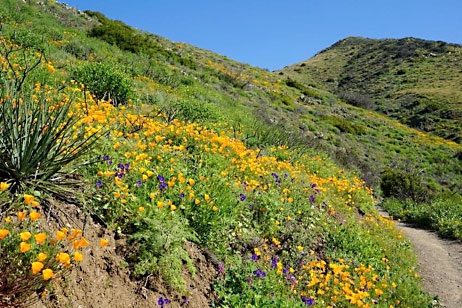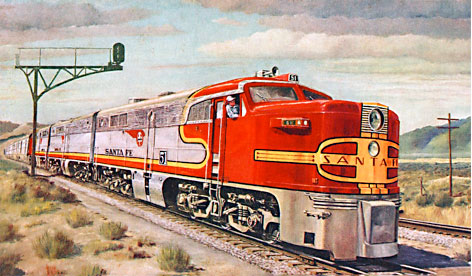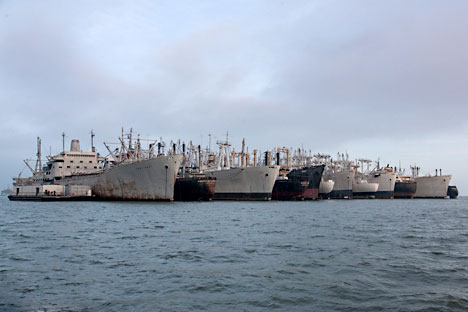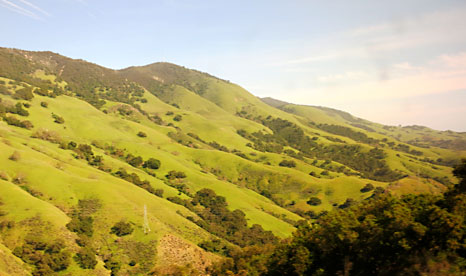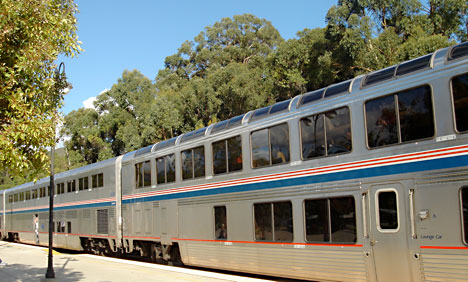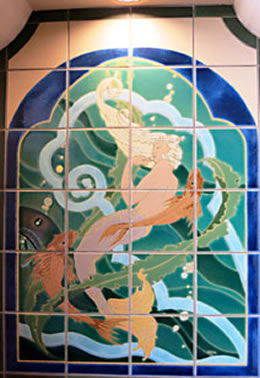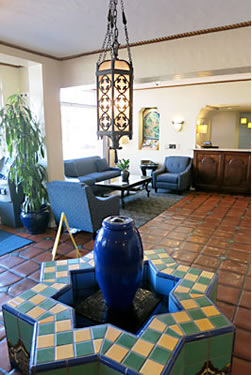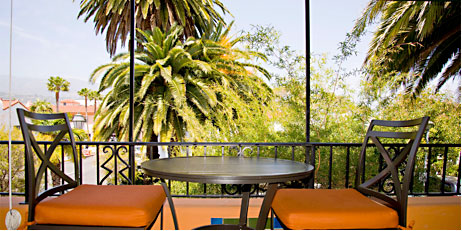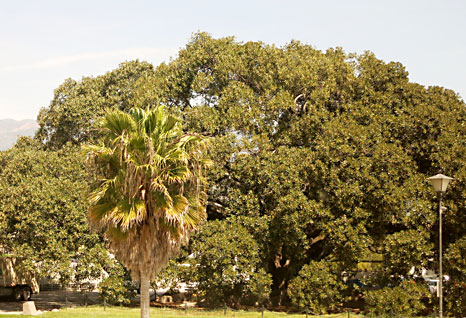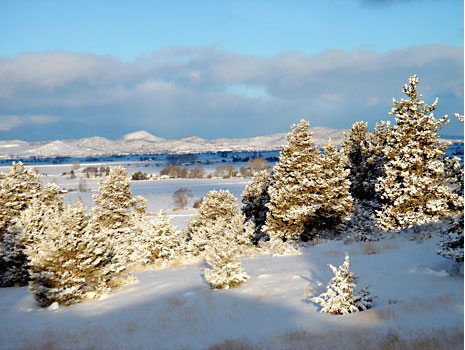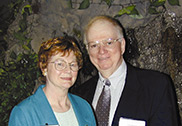CHASING SPRINGTIME ON AMTRAK’S COAST STARLIGHT
|
Here in Klamath Falls we begin our first Amtrak trip since September of last year. "Has it really been that long?" Ted wonders aloud. "How unlike us!" Sylvia, a third generation Californian and a native of San Luis Obispo, remembers early spring there in Central California, when the hills and mountains turned an amazing green and wildflowers burst into bloom. But by March, the grass would start to turn brown (or golden, according to the visitor's bureau). We are tantalized by photos posted on the Internet.
Health issues caused us to cancel an earlier March trip, but our contacts in California had been talking about nothing but rain, rain, rain for the past several months, and assured us that at least in Northern and Central California, that green on green was still in evidence. It was still freezing at nights in Klamath Falls, which is in the high desert. We were ready for a change of both scene and climate. We agreed that a trip to Santa Barbara is just what we need. Fortunately, due to the vagaries of Amtrak's mysterious airline-style inventory control program, the same first-class ticket now costs $200.00 less when rebooked for our later date of travel. A good omen! We use the savings to book a third night in Santa Barbara. Coast Starlight #11 arrives early. It originated in Portland today, having been unable the day before to reach its normal destination in Seattle due to a Service Disruption, in this case a landslide on the rail route between Portland and Seattle - a frequent experience for trains during the rainy season. This will be an uncomplicated, relaxing trip. We've requested a cart transfer over the lengthy platform instead of hiking it with our luggage. The best room we could book is in car 1132, which requires a transit through four other carriages to reach the dining car. Having room service meals delivered rather than struggling through the rocking and rolling train seems like a sensible alternative. Travel Tip: Ted explains. "Nobody told me," she grumbles, but quickly recovers and delivers us courteously to our car. So this explains what has happened to clients who have had us put special requests in the record, but not got the service they were expecting. Remember, the crew is human, and there is a lot of commotion during boarding. So traveler, be prepared to be politely assertive. Our Bedroom E, upstairs, has a small lower bed, 36" x 75". For comparison a standard twin bed measures at 39" x 74", so while the length is more than adequate, the width requires some close cuddling for two people to share. But we find that sharing a narrow lower berth is preferable to one of us climbing the ladder to the upper berth. And the older we get, the harder it is to find a volunteer to teeter up that ladder! Our bed is made up with fresh sheets, four plump pillows, and is looking very inviting after our long, busy day. We forget to ask Blanca, our car attendant, to drop down the upper berth so we will have a place to store things. Thus we squirrel backpacks, etc, under the chair and the bed as best we can, as she retires for the night in Roomette #1 once the boarding passengers are settled, and we don't want to disturb her. The crescent moon peeks through our window. The mattress is quite comfortable, but we tussle a bit with the single blanket. Are they making the blankets smaller, or could it be that we have gained a pound or two? We drink our traditional toast at the beginning of a train trip. Ted, who often took business trips during the 1960s, remembers that trains rode quite smoothly at that time. “You didn’t have to keep grabbing the bulkhead to keep your balance,” he recalls. “I remember standing at the wash basin in my Bedroom A, right over the wheels on the "Super Chief" at 90mph through New Mexico and shaving. Rough tracks were not a problem then.”
Ted, exhausted, sleeps well. I wake about 4 AM, open my novel and sit on the comfortable upholstered chair. The overhead light works fine for reading without disturbing the occupant of the bed, which is an appreciated convenience. Ted, worn down from the reverses all segments of the travel industry have experienced since the inauguration - followed by a surge of pent-up-demand bookings two weeks before our departure - enjoys a late sleep. The sun pops up at 6:56 AM illuminating the industrial clutter, graffiti, and discarded mattresses that now line the tracks in some parts of the Golden State. A huge pot of strong coffee, along with fruit juice and candy surrounded with fresh daises, are available in the upper lobby to early risers. Blanca brings us the continental breakfast, with attractive plates of freshly sliced strawberries, apples, and oranges, and raisin bran with milk and yoghurt. Amtrak's severe "A penny saved is a penny saved" policy surfaces when no morning paper – The Sacramento Bee - is put on board . Guests aren't even given a chance to buy newspapers at station stops now. Those wanting to keep up with the news while traveling on Amtrak will have to do it themselves with their iPhone. We are not iPhone adept, but have brought Ted's Dell laptop along, and are pleased to find that the Coast Starlight is the latest of the long distance trains to offer Wi-Fi. They have promoted this in the past, but a weak and unreliable signal made it essentially useless. Now it works pretty well, some of the time. (On our northbound return trip, there was essentially no Internet access from Santa Barbara to Klamath Falls.) Leaving Sacramento, flooded areas appear, water covering fields and the roots of trees. Books on early history mention that the whole San Joaquin Valley would flood in the spring when steamboats were sent clear across to the foothills of the Sierras carrying gold miners and their supplies. The design of the slick newer Superliner II sleeper, although quite attractive with brand new carpets, has been designed with only one hook on the wall, which makes it impossible to hang hats, scarves, waist packs, etc. Timetables are no longer updated. The one in the room is dated January of last year. Is it accurate? Sylvia wears her old "now we're in California" smile that comes with the thrill of seeing the first palm tree of the trip. Some of our Amtrak customers have hinted at downgraded food, but we find it just the opposite as we consume a delicious room-service picnic lunch of angus burgers with all the trimmings. They have been upgraded to an adult burger with gourmet onion roll, cheddar cheese, and bacon, and taste better than ever. We order steaks, medium rare, with baked potatoes on the return, and rate it better than any fast food burger we've had for some time. There is some open rural country now, and the verdant color we've been craving comes into view. The huge "mothball fleet" of obsolete naval ships appears, and parking lots with acres of imported new cars just off the boat from Asia wait to be delivered to car dealerships.
There is the Golden Gate Bridge to the west! The train is very crowded, with an extra coach. An announcement is made that we need to replace a malfunctioning engine at the Oakland Yards. "It will just take a few minutes," assures the voice. We exchange skeptical glances; nothing out of the ordinary Amtrak does takes just a few minutes. Sure enough, we are in the yards for an hour. But we are in no hurry, particularly since we have a comfortable room with a sofa to relax on should we get tired. And a bonus is that we observe a very European-looking Siemens Charger diesel locomotive painted blue and gray with a Caltrans logo, fresh from the factory in Sacramento.
Amtrak has provided a nice new feature, a system-wide magazine more comprehensive than those the airlines furnish. On the other hand, how would we know what an airline magazine looks like today, since we haven't flown on an airliner for nearly twenty years. Cluttered Silicon Valley comes next, then a loop away from Highway 101 into the remote Pajaro River canyon to Watsonville Junction. Artichokes, corn, and berries flourish here in the summer. The Pajaro River heads towards the ocean, with tidal flats home to white egrets. (We once were delayed here while Amtrak waited until the high tide, which covered the tracks, went out.) Back along Highway 101, we enter the Salinas Valley. Formerly crowded with fields of lettuce, we notice that many of the fields now sport more lucrative grape vines. Other edible green crops are growing here as well. Groups of rusty oil wells nod up and down. The live oaks, which characterize Central California, appear, along with eucalyptus trees. Blue-violet lupine, yellow fields of mustard, and the occasional orange California poppy remind us how fortunate we are to enjoy this late spring. A huge field new of solar panels have been added, along with more subdivisions, since we last came this way. Amtrak added a stop at Paso Robles fairly recently, as the population of the area has skyrocketed. Many Los Angelinos looking for a more leisurely life with less traffic are attracted to this area, which has many homes with room for horses. Some can be seen running nearby with manes flying in the breeze. This area now has a collection of fine wineries, and wine tasting tours are popular. The train begins to climb over the rounded, folded-together hills of the Santa Lucia range. Waxy white yucca, tall as a person, with candle-flame shaped clusters of blooms, will be in flower in two month's time. This is the steep Cuesta Grade between Santa Margarita, where helper steam engines would wait to assist the red, orange, and silver GS streamlined steam locomotives that pulled the old Coast Daylight uphill to San Luis Obispo. We who lived there called them the Noon Daylights as they met here halfway between San Francisco and Los Angeles.
Sylvia's father, Homer Hamlin, worked for the Southern Pacific as a fireman on the GS engines for a time during that era. With steam still in his blood, he would often spend Saturdays hitching rides over the grade and back on the mighty helpers, after he went to work elsewhere. A series of tunnels anchor the summit, which provides a stunning view of the row of miniature extinct volcanoes that start here. This formation ends in the ocean on the far side of Morro Rock. The Cuesta Grade is wild mountain country, with deer near the tracks and unusual rock formations. After the train traverses the Horseshoe Bend at the bottom of the grade, (not as well known as Pennsylvania's Horseshoe Curve but with far more spectacular scenery), Cal Poly comes next. Offering agricultural and animal husbandry courses, the large college property has room for pigs, cattle, and horses which we pass right near the tracks.
It leads right into and the city of San Luis Obispo. When Sylvia left for college in 1955, the population here was 10,001. After a crew change stop here, the tracks head towards their first encounter with the Pacific Ocean, at the extensive sand dunes of Oceano. When Hollywood needs to film a desert scene, they have often used this area. Vandenberg Missile Base has miles of open country. Later, the population gets scarce, with occasional mansions on large acreage at the end of country roads. Ronald Reagan's ranch property is supposed to be somewhere along here, where deep valleys wind into the high green hills on the inland side of the train. On the other side, the windows display the ocean, with waves that look 20 or 30 feet high, and strings of foam blow back in the offshore wind. Nonstop beaches line the coast now. Some have straight-as-an arrow ridges of parallel rock. Others have flat, continuous solid rock bases with strange cross hatching. The ocean is a strange blue/green color, but not even close to aqua. Soon the scenery changes. Mountains now show exposed ridges of sandstone, and chaparral, so typical of Santa Barbara and add a wild west flavor. And so we arrive in this fabled city which carefully retains its Spanish-town character. Here are brilliant, Spanish tiled fountains. White-washed buildings topped with curved terra-cotta roofs. Palms, some tall and thin, others shorter and wider. Some spiky and others feather-like. Lacy wrought iron fences add to the city's exotic look. The foothills and mountains that rise above are covered with view homes and buildings. This is Santa Barbara. We taxi to the Holiday Inn Express on State Street, near the Amtrak station, recently transformed from the 1917 Hotel Virginia.
A blue and green color scheme, and original red Spanish tile with colorful inserts covers the lobby floor. A large tile sporting a mermaid graces one side of the lobby.
There is a second-floor veranda, with comfortable rooms furnished with expensive natural wood furnishings, featuring glimpses of the original red brick walls, and perhaps the most comfortable bed we've ever encountered. While there is no restaurant here, a generous breakfast buffet is complimentary. A room-service menu with off-premises food of various types makes lunch or dinner only a phone call and few minutes away and is delivered to your room, or at your request, to an outdoor table on the veranda.
Soon we are seated on the veranda, enjoying a piping-hot pizza and a bottle of red wine as we watch pedestrians strolling down State Street below. It doesn't get much better than this. Wednesday, April 5, 2017. The northbound Coast Starlight, #14, arrives into Santa Barbara on time at 12:33pm. The last coach is spotted right in front of the station.The sleepers at the head end are so distant, they are nearly over the horizon. Fortunately, the station has an electric cart to transfer anyone with walking issues, which we take advantage of, and are rewarded with a view of the Moreton Bay Fig Tree.
Thursday, April 6, 2017 #14 arrives Klamath Falls on time and we disembark into a shockingly cold wind sweeping through the rail yard, local temperature 44 F. Sky overcast. We haven’t followed the weather reports, and don’t know that a snowstorm is expected. We drive home and get the fireplace going.
Friday, April 7, 2017. The next morning we awake to a winter wonderland, as snow decorates the juniper trees on our property. We’ve had our green fix, and can dream of the spring that still hasn’t reached Klamath Falls.
|
|
||||||||||||
